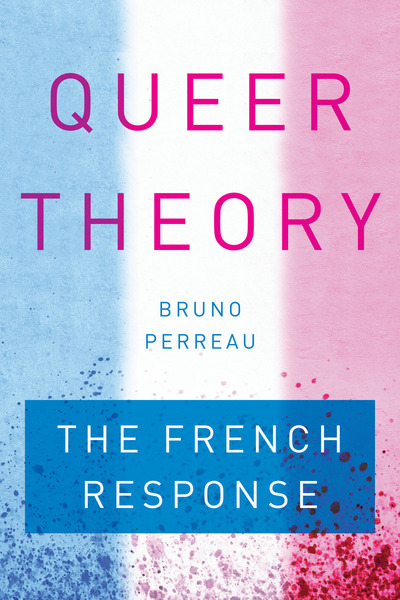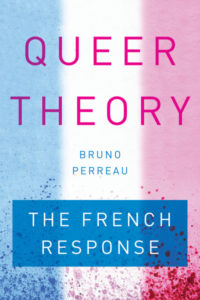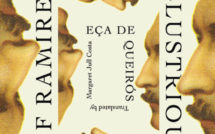
This is part of our special feature The Gender of Power.

Scholarship in gender studies and queer theory abounds today on both sides of the Atlantic. For this American scholar, it has long been clear to me that the work of French thinkers such as Beauvoir, Foucault, Wittig, Derrida, Irigaray, Deleuze and Guattari, Cixous, Baudrillard, Kristeva, and many others, sits at the heart of the writings of such US-based thinkers as Judith Butler, Teresa de Lauretis, Eve Sedgwick, Leo Bersani, and Lee Edelman. However, the viewpoint of many in France, and among Catholics and other conservative thinkers in particular, is that “la théorie du genre” [gender theory] and queer theory in particular, are part of a foreign and largely American invasion that has washed up on their shores to contaminate and even destroy French notions of gender difference, parenting, family, filiation, citizenship, and belonging in their country.
In his new book Queer Theory: The French Response, MIT professor Bruno Perreau aims to analyze how American-style theories of gender and sexuality, and the work of Judith Butler in particular – which was translated largely in the new millennium – have been repackaged by French Catholics, politicians, activists, and others in a way that often invokes a moral panic. Perreau sets the scene with a look at the growing anti-gay marriage movement in France in 2012 and 2013 following the proposal and eventual passing into law of the Taubira Act, which legalized “le mariage pour tous” [marriage for all]. For many French conservatives, the Taubira law questions everything about their model of republican universalism and the symbolic order of gender differences that have long been at the core of their national values. For readers who are already familiar with Perreau’s research, this volume is a natural outgrowth of his thinking in his excellent The Politics of Adoption (2014). Although Perreau calls his new book a “French response” to gender studies and queer theory imported from the US, he stresses that it is a not a reception study, per say, but more one of re-appropriation and diffraction of ideas across time and space. Perreau borrows historian Joan Scott’s concept of the “fantasy echo” in the hopes of showing his reader that “transatlantic exchanges are the product of cultural fantasy whose effect, if not function, is to mask their original source” (7). He continues: “[it] invents a point of reference…clings to it, and by force of repeated telling, effaces the very traces of its making” (8). Indeed, his study is about how the French response to American-style queer theory is one that involves an original source that “can no longer be distinguished from its many reverberations” (9). This is not unlike what Mireille Rosello defined so clearly in her ground-breaking book Declining the Stereotype (1998), where she traces the iterative and almost infectious process of the spread of a cultural stereotype that pollutes a group’s way of thinking. Working in a similar vein to such scholars of France as George Mosse, Florence Tamagne, and Shari Benstock, Perreau qualifies this foreign cultural invasion of homosexuality as one of contamination and destruction (of any future or community).
The first two chapters explain why queer theory has become such a phenomenon in France since 2000. For example, in chapter 1, “Who’s Afraid of Gender Theory?,” Perreau examines the anti-gay movement and its various actors, including the rhetoric of the Socialist party and the Vatican’s push for “human ecology” that aimed to scapegoat “la théorie du genre” in the process. He explains clearly, that since 1962 and the opening of the Second Vatican Council, popes Jean-Paul II, Benedict VIII, and Francis all have defended gender differences as part of the “natural law” based in biology, anthropology, and psychoanalysis, and have not only questioned the term “gender” as part of the gender theory movement, but have critiqued it as part of a “foreign invasion” or “ideological colonization” from abroad. Perreau clarifies, however, that it was the 1995 World Conference on Women in Beijing that served as the flashpoint for the Vatican to target university research on gender and sexuality. The author then shows us how several opponents of gender theory à l’américaine in France followed the Vatican’s call and took shape in the form of organizations like Civitas with street prayers, “Manif pour Tous” (Demo for All) with street marches, as well as Le Printemps Français (French Spring), and other younger groups like Antigone and Hommen who put “Catholic pride” at the center of their resistance movements. These groups all lobbied and fought in their own way for “femininity” for women, a return to “masculinity” for men, and the protection of children from adoption, same-sex parenting, and surrogates. This also involved politicized movements lead by the center right party – L’Union pour le movement populaire (UMP) – and the sometimes participation of the far-right party Le Front National (FN) – and in particular with Marine LePen’s niece Marion Maréchal-Le Pen when she was elected to the National Assembly. At the same time, however, François Hollande was no less guilty with his use of fraught Socialist rhetoric in speaking to French mayors about their “liberty of conscience,” who chose not to officiate same-sex marriages in their own districts. Moreover, many of these movements placed gender and queer theory on par with a strange mix of other bedfellows that included Communism, Marxism, and Nazism, as well as perverts, Jews, “inferior” races, and intellectuals and liberals, all of whom supposedly undermine the body politic (23). The fact that gender theorist Judith Butler is Jewish and that pro-marriage representative Christiane Taubira is from French Guyana, played terribly well in the French context for attacking them as “freaks and monsters” both from the inside and the outside.
One of the most fascinating aspects of this book is Perreau’s analysis of the sanctity of childhood and the child’s body in the French context. The author argues that the Socialist party with its universalist rhetoric aimed to see the country as “one and indivisible,” (46) and to minimize the individual citizen’s claims to self-determination in relation to the body. Moreover, filiation through heterosexual procreation is sacred and children’s bodies should be protected at all cost to ensure that this parent-child link remain intact. According to the French State, procreation technologies were to be reserved for the heterosexual couple and available only in order to correct nature, and not to transform it. Furthermore, and this is one of the most fascinating and troubling parts: “the movements opposing marriage for all and gender theory adopted homoparenthood as a symbol of dangerous changes in the mode of child reading itself, stigmatizing minorities while playing on the fantasy of the ‘corruption’ of minors” (54). This argument underscores the protection of the child and plays largely on the fear of an anti-social order, the homosexual’s “desire to have children,” and the semantic slippage with “desire for children” that links homosexuality and pedophilia (52-53). The French fantasy with American-style queer theory is one of fear of foreign invasion or contamination by a minority culture.
In chapter 2, “The Many Meanings of Queer,” Perreau leads the reader through a succinct genealogy of the emergence of the term “gender” and the development of gender studies and queer theory in the US, including the early work in endocrinology and psychiatry, and then later, more widely in the academy by such scholars as Scott, Butler, Sedgwick, de Lauretis (all mentioned above) as well Gloria Anzaldúa, Gayle Rubin, and Monique Wittig (who eventually moved to and worked in the US). Perreau stresses that these writings remained largely unnoticed in the 1990s in France, except among such HIV activists as Les Sœurs de la Perpétuelle Indulgence and ACT UP Paris, including Didier Lestrade. The author then traces the eventual arrival in France after 2000 of queer theory and its presence among both proponents and opponents in conferences, debates, media events, televised programs, and other outlets. Perreau largely bases the remainder of this chapter on interviews with some forty activists and scholars in France whom he and colleague Natacha Chetcuti recruited through snowball sampling. The author illustrates how a diverse group of pioneering scholars such as Didier Eribon, Eric Fassin, Marie-Hélène/Sam Bourcier, Paul B. Preciado and others engaged with this scholarship in a variety of ways where they certainly did not always see eye-to-eye on interpretation. While the list of participants is quite lengthy and the interpretations of the terms “gender” and “queer” quite diverse to summarize in this review, Perreau does illustrate that cleavages and disagreements abounded in intellectual circles that created fault lines among those who, on the one hand, supported Butler’s work, and those who on the other hand criticized the normative ideologies related to whiteness, privilege, and other category markers embedded therein. He also convincingly illustrates how “queer” essentially went from being a “vague” term that was largely unrecognized in the early 2000s to a term used differently depending on the group. For example, activists like Didier Lestrade (ACT UP Paris) critiqued the term and movement in the 1990s and early 2000s in order to create a more “out of the closet” visibility during the AIDS epidemic and to educate about HIV. In a more recent counter example, media gurus and the mass entertainment industry, including PINK TV and other stations, used “queer” as a euphemism to their own advantage to market and offer television programming that touted “diversity.” Perreau ends the chapter with a comparative analysis of two more recent iterations of queerness as it emerged in the younger generation in France. There is the group Les Tordu(e)s, who denounced “homonationalism” (Puar) and capitalism as part of queer identity making, and, in contrast, the participants in Queer Week at Science Po, the elite school of government in France, who recruited large sponsors to support their events and create lbgt visibility on campus.
In the last two chapters of the book, Perreau shows the reader that the packaging of queer theory in France was full of many contradictions and interpretations, and that nationhood in France was conceptualized largely along lines of biological transmission and blood ties. For example, in chapter 3, “Transatlantic Homecomings” the author offers a brief overview of the scholarship on globalization and sexuality, as well as nationalism and sexuality, and then focuses in on a very astute critique of the work of Jasbir Puar on “homonationalism” in Terrorist Assemblages (2007) and Joseph Massad on the “gay international” in Desiring Arabs (2008). He shows, in particular, the ways in which French scholars have taken up echoes of their work, and then how the socio-political reality and the materials conditions of queers of color in France renders this scholarship largely out of touch in the French context. For example, he critiques Puar’s oversimplification and reification, like that of many other scholars, of identity categories. He relies on the work of Eribon on multitemporalities, and on other scholarship on intersectionality, including the work of sociologist Sirma Bilge, to explain that individual queers can occupy a heterogeneity of spaces and subject positons, which renders Puar’s reading of sexuality and nationalism as myopic (121) based on an analysis of representations and an oversimplification of categories such as “gay” (equating it to white homosexuality) and “blackness” (associating it with only heterosexuality) (122). He also shows how Puar has misread Deleuze and Guattari’s work on deterritorialization by largely ignoring their writing about “minority evolution” and its productive process, which always involves both “friction and bumps” (138). Personally, I would have liked to see more development of this notion in Perreau’s writing, however, I find his critique of Puar’s notion of assemblage to be very productive and it points us in potential new directions. Similarly, Perreau illustrates how several French scholars such as Franck Chaumont, Maxime Cervulle, and Marie-Hélène/Sam Bourcier have all ventriloquized the work of Joseph Massad on the “gay international” by arguing that queers of color in France do not have an authentic voice. Perreau then goes on to point out how scholars like Joseph Boone, Valerie Traub, as well as writers from the Middle East and North Africa, like homosexual Moroccan author Abdellah Taïa, provide poignant counterarguments to Massad’s claim that homosexuality doesn’t exist in those countries or that homosexuals in those countries do not have their own agency or voice (128-131). Perreau ultimately argues that queer analysis must move back and forth between global and local contexts: “The stakes behind transnational queer analysis requires that we note the multiplicity of systems of identification not to oppose them but to show how they may take on several meanings simultaneously without those meanings being necessarily logical or coherent” (134). I cannot endorse too strongly Perreau’s argument here. Multiple sources including Eribon’s writing on multi-temporalities, as well as my own Queer Maghrebi French: Language, Temporalities, Transfiliations (2017), are calling for a move away from depoliticized queer theory and an “ornamental intersectionality” (Bilge), which neglects to question the conceptual categories that Puar and Massad tend to reify and perpetuate. These sources move us more toward the productive direction of lived experiences, empirical evidence, and a “truly democratic queer politics” (143). Perreau’s strength lies in his statement of these interests and this movement, which he communicates clearly and concisely. He concludes and I would agree: “queer analysis is interested in what makes human lives simultaneously ordinary and extraordinary. That is the angle from which queerness can critique State power based both on the myth of heroic founders and on a presumption of the docility of the masses” (141).
In Chapter 4, Perreau brings us back in time to the period surrounding World War I to explain the pathologzation of sexuality, as well as the specter of homosexuality and treason that haunted that historical period. He illustrates the long-standing association in the French mind between the fear of the Jewish body and other outsiders like homosexual “perverts,” colonial subjects, and other invisible traitors of the nation. The author then ties the specter of the queer/Jewish/homosexual/treacherous body to the contemporary “resistance” movement in France, whose actors fight against these “outsiders” along with their queer politics, and sense of individualism and communitarianism. For example, Perreau shows the reader that France’s Socialist party today, along with some LGBT associations and their supposed “experts,” rely on many of those historical fears in their own rhetoric in order to minimize the collective rights of “queers” and to replace them with the rights of each (queer) citizen, individually (156) as part of the French republic. Perreau also shows the reader how conservatives criticized an American-style queer theory for its supposed world view where everything is performance and where gender is only a copy without an original; and this was quite unbearable for politicians and what they saw as the role of schools in shaping the nation’s children. In fact, Socialists withdrew a gender theory program proposed for French middle schools because of the general fear of the transmission of “individuality” instead of “culture” (160), as well as the reproduction of homosexuality, the disappearance of the family, and a fear of the death drive. For conservatives, education is not about performativity, but about a divine model that reinforces the symbolic order of gender differences, family, and heritage. Indeed, as Perreau shows, much of the conservative rhetoric in France relies on the fantasy echoes of the work of Lee Edelman and Leo Bersani on the death drive and the idea of no queer future in order to steer French political agendas away from a specter of sameness, communitarianism, theatricality, contagion, death, or the like.
At the end of this chapter, and in his conclusion, Perreau opens it up by arguing that belonging to a group or a nation is never a totality, it involves frictions and bumps (à la Deleuze and Guattari). He also argues that if queer theory would make this very claim more broadly, doing so would benefit all of us on both sides of the Atlantic. Perreau draws on the work of Nicolas de Condorcet, who states that “a majority is nothing other than the imperfect and temporary accumulation of minority experiences” (187). Hence, in line with Condorcet, Perreau asks us to consider the idea of a multifaceted model of belonging or a “multipositionality,” what he refers to as a “minority democracy,” in order to rethink how we belong to society, how we transmit heritage to the next generation, and how we transform a society. This reader in particular hopes that one of Perreau’s next projects will be to answer some of these very important questions, because, for the time being. they remain largely…open and … theoretical like queer theory itself. This is not a criticism per se, as any book worth its salt concludes by raising new and exciting questions and, in this way, Perreau does not disappoint. In sum, Bruno Perreau does a superb job in showing the reader how queer theory in France emerged through a broad range of iterations across the political spectrum. Queer Theory: The French Response is an excellent contribution to the field of gender studies, queer theory, and political theory, and it will interest anyone concerned with the evolving political landscape in Europe and the United States. It should be essential reading for scholars and students in gender studies and queer theory who are also committed activists interested in thinking beyond “homonationalism” and the “gay international.” Perreau’s new book encourages us all to seek and create new narratives where being queer means simultaneously “coming and going” instead of simply “coming out.”
Reviewed by Denis M. Provencher, University of Arizona
Queer Theory: The French Response
by Bruno Perreau
Publisher: Stanford University Press
Hardcover / 288 pages / 2016
ISBN: 9780804798860
To read more book reviews, please click here.
Published on July 6, 2017.




